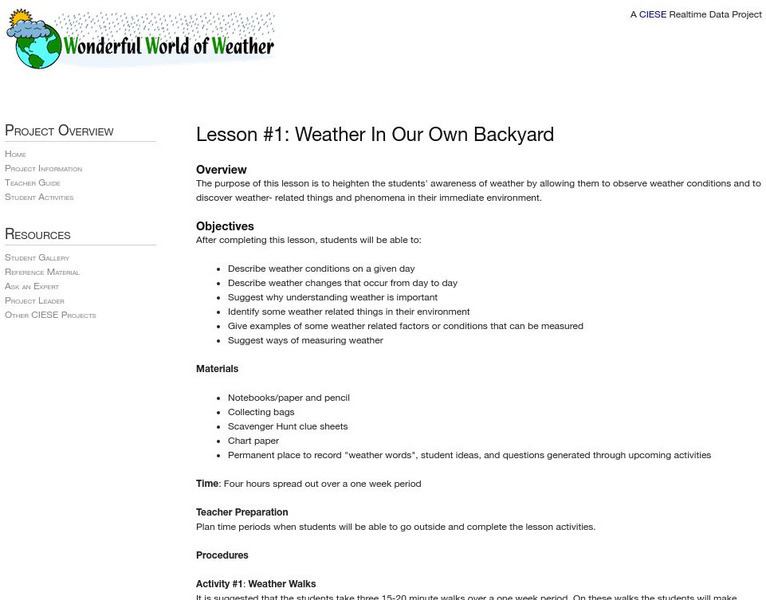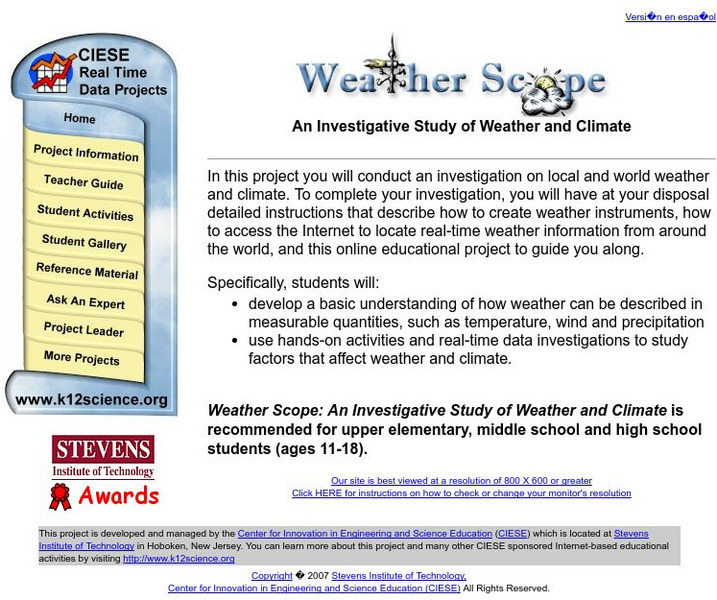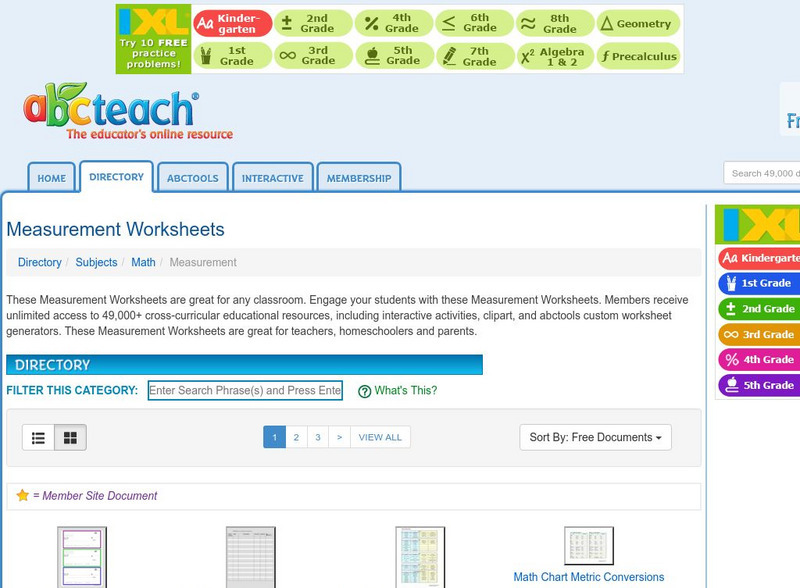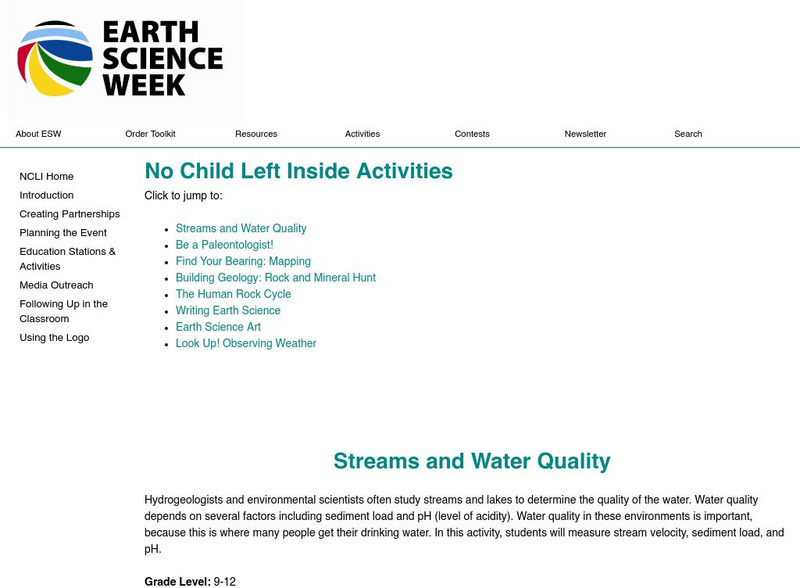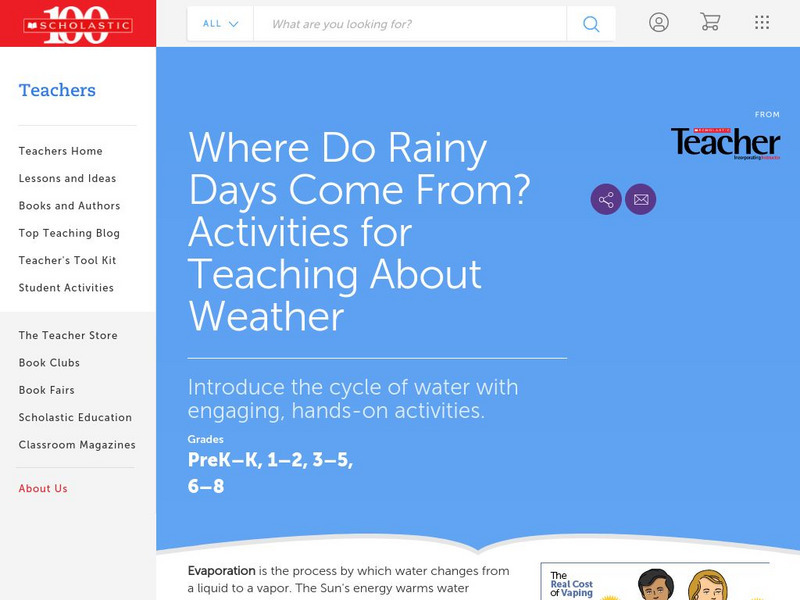National Geographic
National Geographic: Measuring Weather With Tools
Work with students to identify and understand the tools used to measure weather and how they're used.
Other
Siemens Science Day: Earth Science: How's the Weather? [Pdf]
Students make their own weather station by using homemade version of real weather measurement equipment and use their equipment to make observations and predictions about the local weather.
Center for Innovation in Engineering and Science Education, Stevens Institute of Technology
Ciese Real Time Data Projects: Weather in Our Own Backyard
This instructional activity is divided up into three activities, two of which take place outside. By the end of the instructional activity students will be able to describe weather conditions on a given day and some of the factors that...
Center for Innovation in Engineering and Science Education, Stevens Institute of Technology
Ciese Real Time Data Projects: Weather Scope: A Study of Weather and Climate
Use real-time data to study factors that affect weather and climate, create weather instruments, and share data with students around the world.
Center for Innovation in Engineering and Science Education, Stevens Institute of Technology
Ciese: Weather Scope: An Investigative Study of Weather and Climate
The activities in this comprehensive weather unit are designed for Grade 6 and up. Learners will use real time data from around the world to conduct an investigation about weather and climate.
Science Education Resource Center at Carleton College
Serc: Investigating Sedimentary Rock Deposition and Weathering
Middle schoolers will hike to the Mawikwe Bay Sea Caves along the frozen shoreline of Lake Superior in order to investigate the sedimentary rock deposition and weathering of the sandstone cliffs. Students will measure take measurements,...
National Geographic
National Geographic: Educator Resources: Extreme Weather on Other Planets
Find lesson plans, worksheets, photo galleries, and related links for teaching about the weather systems of planets in our solar system.
Center for Innovation in Engineering and Science Education, Stevens Institute of Technology
Ciese: Wonderful World of Weather Project
If you're studying the weather, this is an excellent project for students to develop their understanding of how weather is measured. They will use real time data from their location as well as from around the world to learn about weather...
Center for Innovation in Engineering and Science Education, Stevens Institute of Technology
Ciese Real Time Data Projects:collecting Weather Data and Keeping a Weather Log
Over a period of two weeks students will use their class-made instruments to measure and record weather data. Students will also compare their data to online weather data. The final activity involves analyzing the collected data to look...
PBS
Pbs Teachers: Weather: Temperature Measurement
In this activity, students learn how to convert measures of temperature between the three different scales - Fahrenheit, Celsius and Kelvin. The history and uses of each are very briefly explained as well.
American Geosciences Institute
American Geosciences Institute: Earth Science Week: Build Your Own Weather Station
Students are guided in how to build their own weather station that will measure temperature, humidity, precipitation, atmospheric pressure, and wind direction and speed.
Science Buddies
Science Buddies: Measure the Pressure
Scientists have developed an instrument called a barometer that can measure atmospheric pressure. In this activity, you will find out how a barometer works by building one yourself.
Dan Satterfield
Dan's Wild Weather Page: Winds
Find out about wind and jet streams and the tools that measure them.
Geographypods
Geographypods: Theme 2: Natural Environments
A rich collection of highly engaging learning modules on topics related to the natural environment. Covers four main areas - plate tectonics, forms and processes, weather and climate, and rainforest and desert. Within each of these,...
The Franklin Institute
Franklin Institute Online: Make Your Own Rain Gauge
Make a simple rain gauge to measure the precipitation.
abcteach
Abcteach: Math: Measurement
[Free Registration/Login Required] Teachers will find a variety of worksheets, booklets, conversion charts, warm-up activities and more on measurements. There is even one activity that could be used in a French language class which...
American Geosciences Institute
American Geosciences Institute: Earth Science Week: Look Up! Observing Weather
To get a better idea of how meteorologists make weather predictions, students will begin their own weather journals and make rain gauges.
Texas Instruments
Texas Instruments: Measuring Air Pressure
This activity is intended for an Introductory Meteorology class; an earth science elective intended for Juniors and Seniors. (It was orginally modifed from an Introductory Meteorology Laboratory Assigment taught to undergraduates at...
TeachEngineering
Teach Engineering: Building a Barometer
Students investigate the weather from a systems approach, learning how individual parts of a system work together to create a final product. Students learn how a barometer works to measure the Earth's air pressure by building a model out...
Huntington Library
Huntington Library: Making Community Measurements: Abiotic Factors [Pdf]
A lesson plan in which learners explore plant communities and observe different types of soil and weather conditions in an attempt to determine cause and effect relationships. Includes discussion questions, extension activities and web...
Geographypods
Geographypods: Weather and Climate Graphing It!
Explores the difference between weather and climate and how they are measured. Students will complete activities and construct a climate graph from raw data. They will also learn about the physical structure of the rainforest, its...
Dan Satterfield
Dan's Wild Wild Weather Page: Humidity
Use this site to find out how humidity works and perform some activities related to humidity.
Science Education Resource Center at Carleton College
Serc: Measuring and Comparing Temperatures
Using thermometers, students will compare differences in the temperature of various materials and locations. They will record and chart the data that was collected and present the graphs to their classmates.
Scholastic
Scholastic: Where Do Rainy Days Come From?
Find out more about rainy days when you check out this resource, which features hands-on interactive activities, experiments, fun facts, and more.

![Siemens Science Day: Earth Science: How's the Weather? [Pdf] Activity Siemens Science Day: Earth Science: How's the Weather? [Pdf] Activity](https://d15y2dacu3jp90.cloudfront.net/images/attachment_defaults/resource/large/FPO-knovation.png)
